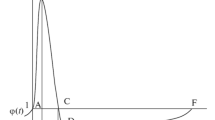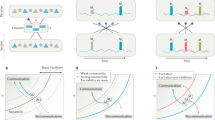Abstract
We show how hierarchical networks may be constructed of interconnected oscillatory network modules developed previously as models of olfactory cortex, or caricatures of “patches”of neocortex. The architecture is such that the larger system is itself a special case of the type of network of the submodules, and can be analysed with the same tools used to design the subnetwork modules. A particular subnetwork is formed by a set of neural populations whose interconnections also contain higher order synapses. These synapses determine attractors for that subnetwork independent of other subnetworks. Each subnetwork module assumes only minimal coupling justified by known anatomy. An N node network can be shown to function as an associative memory for up to N/2 oscillatory and N/3 chaotic memory attractors.
The modules can learn connection weights between themselves which will cause the system to evolve under a clocked “machine cycle” by a sequence of transitions of attractors within the modules, much as a digital computer evolves by transitions of its binary flip-flop states. Thus the architecture employs the principle of “computing with attractors” used by macroscopic systems for reliable computation in the presence of noise. Clocking is done by rhythmic variation of certain bifurcation parameters which hold sensory modules clamped at their attractors while motor states change, and then clamp motor states while sensory states are released to take new states based on input from external motor output and internal feedback.
Simulations show robust storage of oscillatory attractor transition sequences in a system with a sinusoidal clock and continuous oscillatory intermodule driving. The phase-locking or “binding” which occurs rapidly between coupled attractors of similar resonant frequency in different modules is important for reliable transitions. We show analytically how modular networks with more fault tolerant and biologically plausible distributed patterns can be built from “spreading activation” style networks which use single node representations.
Access this chapter
Tax calculation will be finalised at checkout
Purchases are for personal use only
Preview
Unable to display preview. Download preview PDF.
Similar content being viewed by others
References
B. Baird. A bifurcation theory approach to vector field programming for periodic attractors. In Proc. Int. Joint Conf. on Neural Networks, Wash. D.C., pages 1:381–388, June 1989.
B. Baird. Bifurcation and learning in network models of oscillating cortex. In S. Forest, editor, Emergent Computation, pages 365–384. North Holland, 1990. also in Physica D, 42.
B. Baird. A learning rule for cam storage of continuous periodic sequences. In Proc. Int. Joint Conf. on Neural Networks, San Diego, pages 3: 493–498, June 1990.
B. Baird. Bifurcation Theory Approach to the Analysis and Synthesis of Neural Networks for Engineering and Biological Modeling. Research Notes in Neural Computing. Springer, 1992. to appear.
B. Baird, W. Freeman, F. Eeckman, and Y. Yao. Applications of chaotic neu-rodynamics in pattern recognition. In SPIE Proceedings Vol. 1469, 1991. in press.
R. Eckhorn, R. Bauer, W. Jordan, M. Brosch, W. Kruse, M. Munk, and H. Reitboeck. Coherent oscillations: A mechanism of feature linking in the visual cortex? Biological Cybernetics, 60:121, 1988.
A. K. Engel, P. Konig, C. Gray, and W. Singer. Synchronization of oscillatory responses: A mechanism for stimulus-dependent assembly formation in cat visual cortex. In R. Eckmiller, editor, Parallel Processing in Neural Systems and Computers, pages 105–108. Elsevier, 1990.
J. Freeman, W. Y. Yao, and B. Burke. Central pattern generating and recognizing in olfactory bulb: A correllation learning rule. Neural Networks, 1(4):277, 1988.
W. Freeman. Mass Action in the Nervous System. Academic Press, New York, 1975.
W. Freeman. Simulation of chaotic eeg patterns with a dynamic model of the olfactory system. Biological Cybernetics, 56:139, 1987.
W. Freeman and B. Baird. Relation of olfactory eeg to behavior: Spatial analysis. Behavioral Neuroscience, 101:393–408, 1987.
W. J. Freeman and B. W. van Dijk. Spatial patterns of visual cortical eeg during conditioned reflex in a rhesus monkey. Brain Research, 422:267, 1987.
C. Gray, P. Konig, A. Engel, and W. Singer. Oscillatory responses in cat visual cortex exhibit intercolumnar synchronization which reflects global stimulus properties. Nature (London), 338:334–337, 1989.
J. Guckenheimer and D. Holmes. Nonlinear Oscillations, Dynamical Systems, and Bifurcations of Vector Fields. Springer, New York, 1983.
L. B. Haberly and J. M. Bower. Olfactory cortex: model circuit for study of associative memory? Trends in Neuroscience, 12(7):258, 1989.
D. Horn and M. Usher. Parallel activation of memories in an oscillatory neural network. Neural Computation, 3(1):31–43, 1991.
J. Jack, D. Noble, and R. Tsien. Electric Current Flow in Excitable Cells. Clarendon Press, Oxford, 1983.
M. Jordan. Motor learning and the degrees of freedom problem. In M. Jeanerod, editor, Attention and Performance, XIII, Hillsdale, NJ, 1990. Laurence Erlbaum.
Z. Li and J. Hopfield. Modeling the olfactory bulb and its neural oscillatory processings. Biological Cybernetics, 61:379, 1989.
J. McClelland and D. Rummelhart. An interactive activation model of context effects in letter perception, part i: an account of basic findings. Psychological Review, 5:375–407, 1981.
M. Mozer. Connectionist music composition based on melodic, stylistic, and psychophysical constraints. Tech Report CU-CS-495–90, Univ. of Colorado at Boulder, 1991.
J. H. Schmidhuber. A local learning algorithm for dynamic feedforward and reccurent networks. Connection Science, 1:719–722, 1990.
C. von der Malsburg. How are nervous structures organized? In E. Basar, H. Flo, H. Hken, and A. Mandell, editors, Synergetics of the Brain, pages 238–249. Springer, 1983.
D. Wang, J. Buhmann, and C. von der Malsburg. Pattern segmentation in associative memory. Neural Computation, 2(1):94–106, 1990.
Author information
Authors and Affiliations
Editor information
Editors and Affiliations
Rights and permissions
Copyright information
© 1992 Springer-Verlag London Limited
About this paper
Cite this paper
Baird, B. (1992). Information Processing by Dynamical Interaction of Oscillatory Modes in Coupled Cortical Networks. In: Taylor, J.G., Caianiello, E.R., Cotterill, R.M.J., Clark, J.W. (eds) Neural Network Dynamics. Perspectives in Neural Computing. Springer, London. https://doi.org/10.1007/978-1-4471-2001-8_14
Download citation
DOI: https://doi.org/10.1007/978-1-4471-2001-8_14
Publisher Name: Springer, London
Print ISBN: 978-3-540-19771-3
Online ISBN: 978-1-4471-2001-8
eBook Packages: Springer Book Archive




